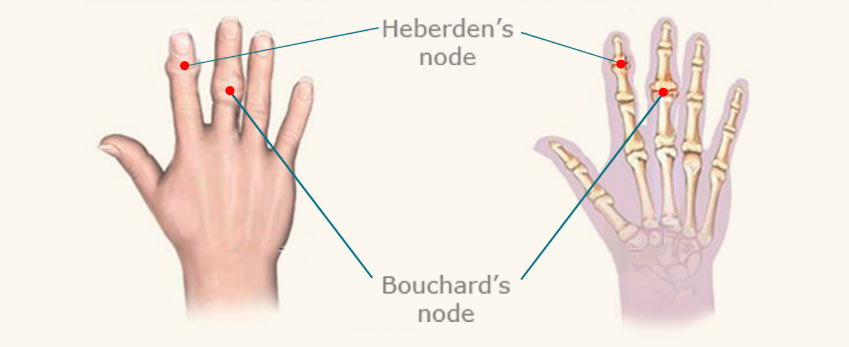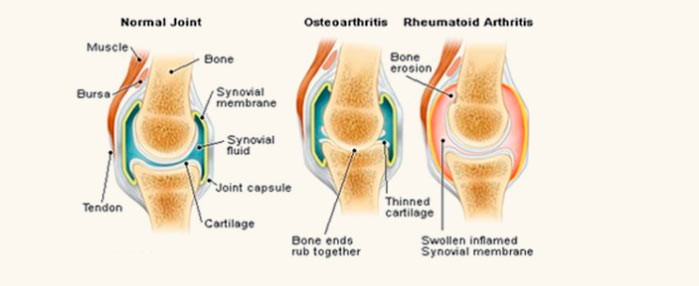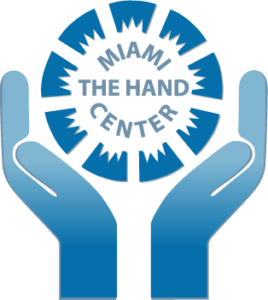There are a number of factors that can result in Osteoarthritis
Occupation
Physically demanding jobs also play a major role in developing arthritis. Studies show that jobs in construction and manufacturing require repetitive and hazardous activity with hands.
Age
When people age, it is natural to lose cartilage. People are more likely to develop arthritis later in life.
Genetics
It is possible patients can inherit arthritis, there are certain genes that might make an individual more prone to the disease than others however It is unknown how much genetics can contribute to arthritis.
Obesity
Obesity has become a serious problem in the U.S and has resulted in the accelerated progression in arthritis. Excess weight puts unnecessary pressure on joints and sharply increases one’s chances of developing arthritis. Even a slight change in weight can result in stronger pain in joints.
Symptoms of Osteoarthritis

Heberden’s node
Fingers may form nodes called Heberden’s node. The nodes are round and boney, they appear very swollen. Heberden’s nodes are caused directly by osteoarthritis due to the consistent trauma the bones must endure when joints lack cartilage. The swollen boney outgrowths appear at the end of the fingers or toes.
Bouchard’s node
Bouchard’snode is very similar to Heberden’s node but is located in the middle of joints in the fingers or toes. The Bouchard’s node is less common than Heberden’s node. They are believed to be caused by osteophytes.
Symptoms of osteoarthritis also include stiffness in the hands, swelling, chronic pain, difficulty grasping objects. Pain becomes more noticeable when doing mundane or repetitive tasks. Opening jars or cans become much more difficult and painful. Pain in your hands causes you to wake up at night. Less strength overall in your hands and limiting range in motion.
Normal & Arthritic Joints

How is Osteoarthritis Diagnosed?
X-ray
An x-ray exam of the joints can indicate a presence of osteoarthritis. X-ray exams can be used to evaluate the loss of cartilage, narrowing of joint spaces, and bone spurs. Bone spurs are the formation of bone over joints when a patient suffers from the effects of osteoarthritis.
Arthrocentesis
Arthrocentesis is a needle syringe that extracts samples of joint fluids for analysis. The procedure is done at the doctor’s office with a local anesthetic. The use of Arthrocentesis is not only diagnostic but also therapeutic. The extraction of joint fluid provides temporary relief for patients. once the joint fluid is extracted it is then sent to a lab for examination.
Normal joint fluid appears clear or light yellow in nature, if the joint fluid is cloudy or bloody that may indicate an abnormality within the joint due to inflammation and or infection. This also leads to an unusual presence of white blood cells, a natural response from the body to fight off infection. This can be a sign of inflammatory arthritis gout or Pseudogout.
Arthroscopy
Arthroscopy is surgical technique that involves inserting a tube like camera into the joint for precise diagnoses. It is the final stage of examination.
Hand Procedures
- Arthroscopic Surgery
- Burns
- Carpal Tunnel
- Distal Radial Fracture
- Dupuytren Contracture
- Fingertip Injury
- Microvascular Surgery
- Osteoarthritis
- Trigger Finger
Miami Hand Center
(305) 642-4263
